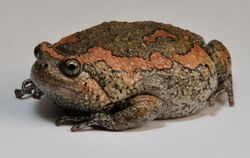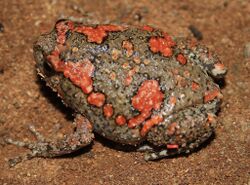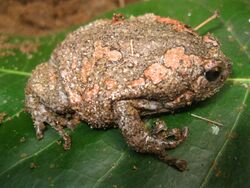Biology:Kaloula taprobanica
| Kaloula taprobanica | |
|---|---|

| |
| Scientific classification | |
| Domain: | Eukaryota |
| Kingdom: | Animalia |
| Phylum: | Chordata |
| Class: | Amphibia |
| Order: | Anura |
| Family: | Microhylidae |
| Genus: | Kaloula |
| Species: | K. taprobanica
|
| Binomial name | |
| Kaloula taprobanica Parker, 1934
| |
| Synonyms | |
|
Kaloula pulchra Parker, 1934 | |
The Sri Lankan painted frog, Sri Lankan bullfrog sometimes just called the painted frog (Kaloula taprobanica) is a species of narrow-mouthed frog found in Nepal, Bangladesh, southern and eastern India and Sri Lanka[2] up to an altitude of about 1300 metres.[1] It is a common species, the adult of which is up to 75 millimetres long from snout to vent. It was originally described as a subspecies of Kaloula pulchra, ssp. taprobanica.[3] The IUCN lists it as being of "Least Concern".[1]
Phylogeny
Blackburn, et al. (2013)[4] suggests that K. taprobanica might not form a clade with the other Kaloula species, although it does clearly form a clade with Metaphrynella, Ramanella, and the rest of Kaloula. De Sá et al. (2012)[5] groups K. taprobanica as a sister clade to Ramanella and Uperodon rather than with the rest of Kaloula, which De Sá et al. (2012) lists as a sister clade to Metaphrynella and Phrynella.
Description
This plump species of frog attains a snout-to-vent length of about 75 millimetres (3.0 in), with females being slightly larger than males. The colour of the dorsal surface is greyish-black with a symmetrical pattern of reddish-brown patches on either side including a band of colour stretching from the back of the eye to the base of the arm. The underparts are pale yellowish-grey, mottled with black or brown. During the breeding season, males develop a dark throat patch.[3]
Distribution and habitat
The Sri Lankan painted frog is native to Sri Lanka but also to India, Bangladesh and Nepal. Kaloula taprobanica and Kaloula assamensis are located to the west and north of the Brahmaputra River, while Kaloula pulchra is located to the east and south of it, since the Brahmaputra River serves as a barrier to dispersal.[6]
The Sri Lankan painted frog is a fossorial species, spending the day buried in the leaf litter, in loose soil or under fallen logs, but can also climb into the branches of trees. The habitats it prefers include dry forests, coconut and rubber plantations, wetlands, rice fields and disturbed areas close to dwellings.[1]
Behaviour
This frog feeds on a variety of insects. It breeds at the start of the rainy season and males call from suitable water bodies. The eggs float on the surface of the water in a single layer. The tadpoles are black.[3]
Status
This frog has a wide range and the population seems to be reasonably stable. The IUCN rates it as being of "Least Concern" as it considers that the rate of decline, if any, is insufficient to justify listing it in a more threatened category. This frog is common over much of its range and the threats it faces have been identified as degradation of its habitat and pollution by agrochemicals of the water bodies in which it breeds.[1]
References
- ↑ Jump up to: 1.0 1.1 1.2 1.3 1.4 Inger, R.F.; Gour-Broome, V.A.; Manamendra-Arachchi, K.; de Silva, A.; Dutta, S. (2016). "Uperodon taprobanicus". The IUCN Red List of Threatened Species (IUCN) 2016: e.T57858A91639191. doi:10.2305/IUCN.UK.2016-1.RLTS.T57858A91639191.en. http://www.iucnredlist.org/details/57858/0. Retrieved 3 January 2018.
- ↑ Frost, Darrel R. (2013). "Kaloula taprobanica Parker, 1934". Amphibian Species of the World 5.6, an Online Reference. American Museum of Natural History. http://research.amnh.org/vz/herpetology/amphibia/?action=names&taxon=Kaloula+taprobanica. Retrieved 11 December 2013.
- ↑ Jump up to: 3.0 3.1 3.2 Janzen, Peter (2005-05-01). "Kaloula taprobanica". AmphibiaWeb. http://www.amphibiaweb.org/cgi-bin/amphib_query?where-genus=Kaloula&where-species=taprobanica. Retrieved 2013-12-11.
- ↑ Blackburn, D. C., Siler, C. D., Diesmos, A. C., McGuire, J. A., Cannatella, D. C. and Brown, R. M. (2013), An adaptive radiation of frogs in a southeast Asian island archipelago. Evolution, 67: 2631–2646.
- ↑ De Sá, R. O., Streicher, J. W., Sekonyela, R., Forlani, M. C., Loader, S. P., Greenbaum, E., … Haddad, C. F. B. (2012). Molecular phylogeny of microhylid frogs (Anura: Microhylidae) with emphasis on relationships among New World genera. BMC Evolutionary Biology, 12, 241. http://doi.org/10.1186/1471-2148-12-241
- ↑ Saibal Sengupta, Abhijit Das, Sandeep Das, Balhtiar Hussain, Nripendra Kumar Choudhury and Sushil Kumar Dutta. 2009. Taxonomy and Biogeography of Kaloula Species of Eastern India. The Natural History Journal of Chulalongkorn University. 9(2): 209-222.
- Dutta, S.K. and Manamendra-Arachchi, K. (1996). The Amphibian Fauna of Sri Lanka. Wildlife Heritage Trust of Sri Lanka, Colombo, Sri Lanka.
Wikidata ☰ Q28024322 entry





